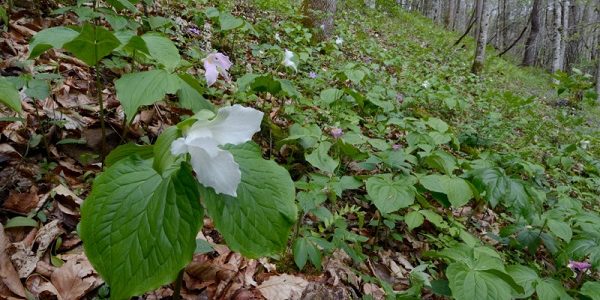Mesophytic Cove Sites

What are mesophytic cove forests?
What are Mesophytic Cove Forests?
Mesophytic cove forests are highly diverse hardwood forests in the Appalachian region that occur on sheltered, low- to mid-elevation valleys and ravines. Cove forests have high species richness and diversity, fertile soils, and complex forest structure. Subtle changes in slope position, soil moisture, nutrient status, and other factors drive vegetation changes across short distances. These forests are dominated by a high diversity of mesophytic hardwood tree species such as tulip poplar, black walnut, red maple, eastern hemlock, and cucumber tree. Standing dead trees (snags) and large downed logs are important wildlife habitat elements in cove forests. These forests also provide human communities with timber resources, recreational opportunities, abundant wildlife, and a broad array of non-timber forest products. As a result, they are culturally significant across the region.
There are two dominant types of mesophytic cove forests in Appalachia: acidic cove forests and rich cove forests. Acidic cove forests occur in sheltered sites primarily in narrow rocky gorges, steep ravines, and low gentle ridges within coves. They are dominated by acid-tolerant trees and shrubs such as red maple, eastern hemlock, and great rhododendron. Rich cove forests occur in sheltered mesic sites, often on concave slopes with richer soils. One of the first indicators of a rich cove forest is the abundance of understory herbaceous growth with species such as bloodroot and trilliums. Dominant tree species include yellow buckeye, white ash, and basswood.
Current status
While mesophytic cove forests are not particularly rare, sites that exhibit later successional characteristics and still retain a dense canopy and high overstory and understory species diversity are quite rare. Mesophytic cove forests in the old-growth phase of stand dynamics are especially rare and are typically located in protected areas or are generally inaccessible for forest management. In the last two centuries over 95 percent of this forest type has been converted or degraded to some degree.
The most significant threat to mesophytic cove forests is disturbance through incompatible forest management practices. Cove forests may be altered when management veers substantially from natural disturbance patterns, and once-diverse stands can be dominated by tulip poplar, red maple, and an influx of non-native invasive plant species. Management practices such as clearcuts or high-grading (unsustainably removing the largest and highest value trees) do not mimic the natural disturbance patterns of cove forests and can lead to undesirable alterations in forest structure and species composition. High-grading (often referred to as diameter-limit cutting) leaves less-valuable species, damaged residual trees, and trees with poor form, all of which reduce stand diversity and silvicultural options.
In addition to sub-optimal forest management, other important threats to cove forests include invasive plants, pests, and pathogens, increased browse by overabundant deer populations, overharvest of rare plants, climate change, and pollution.
Futher reading
Elliott, Katherine J.; Vose, James M.; Rankin, Duke. 2014. Herbaceous species composition and richness of mesophytic cove forests in the southern Appalachians: synthesis and knowledge gaps. The Journal of the Torrey Botanical Society, 141(1):39-71.
Loucks, C., Olson, D., Dinerstein, E., Weakley, A., Noss, R., Stritholt, J., & Wolfe, K. (n.d.). "Appalachian mixed mesophytic forests" | Ecoregions | WWF. World Wildlife Fund. Retrieved June 19, 2020, from https://www.worldwildlife.org/ecoregions/na0402
Schafale, M. P. (2012). Mountain Cove Forests. In Classification of the Natural Communities of North Carolina (Fourth Approxiation) (4th ed., pp. 16–23). NC Natural Heritage Program.
Resources
Webinar: Ecological Forestry in Mountain Coves of the Appalachian Region, May 2020.
Factsheet: Identification and Mitigation of Invasive Species in Coves
Appalachian Cove Virtual Series
- Wild Ginseng Conservation and Management webinar and study companion
- Tom's Run field tour recording and study companion
- Managing Invasive Plants in Coves webinar and study companion
- Aquatic Biodiversity webinar and study companion
September 2021 Workshop in Morgantown, WV
- Mountain Cove Forest Management in Central Appalachians, Guild intro
- Exploring Cove Forests by Jamie Schuler, WV University Division of Forestry & Natural Resources
- Opportunities for Enhancement Through Responsible Forest Management by Melissa Thomas-Van Gundy, USDA FS WV
- Timber Harvest Planning and Execution and Invasive Species Management by Russ Richardson, Appalachian Investments
- Managing Cove Forests with Water Quality and Watershed Health Considerations by Chad Landress, Fisheries Biologist, Monongahela National Forest
Stay Informed
about our recent projects and upcoming events.
